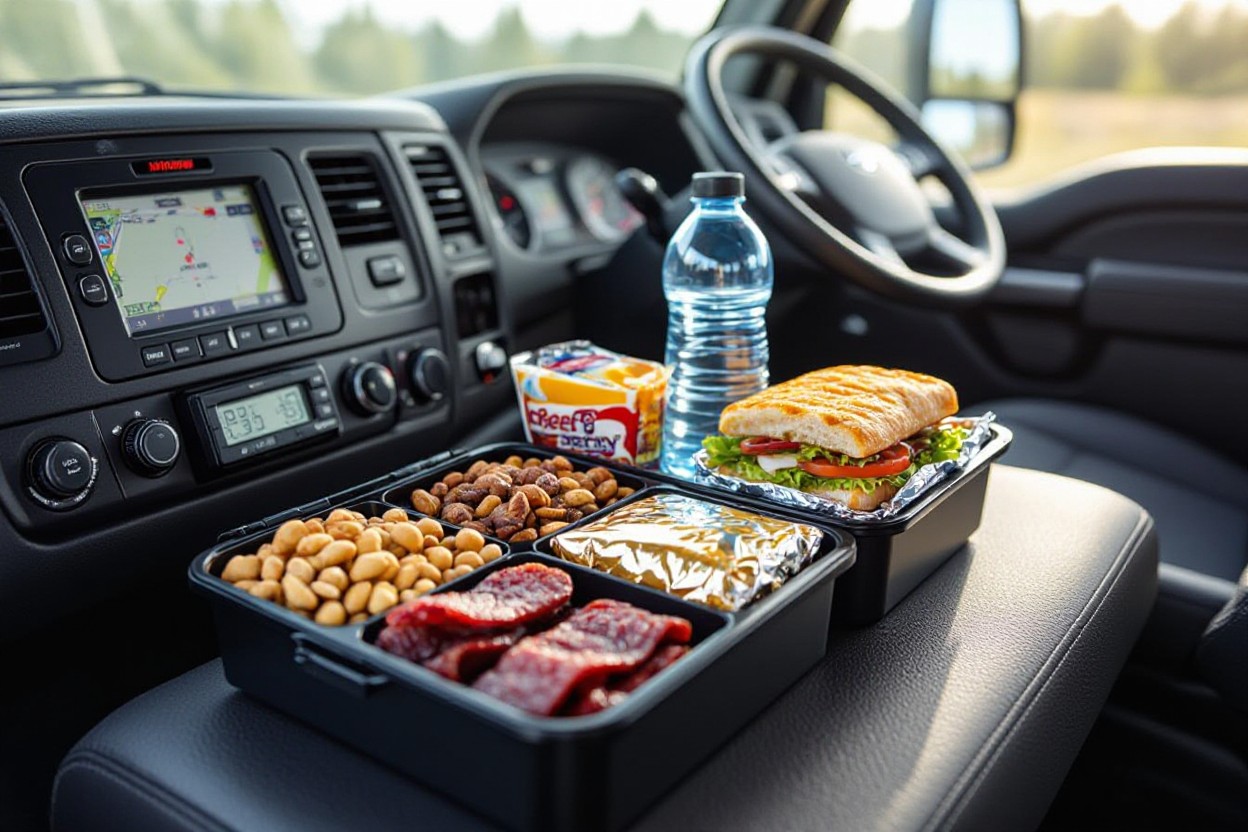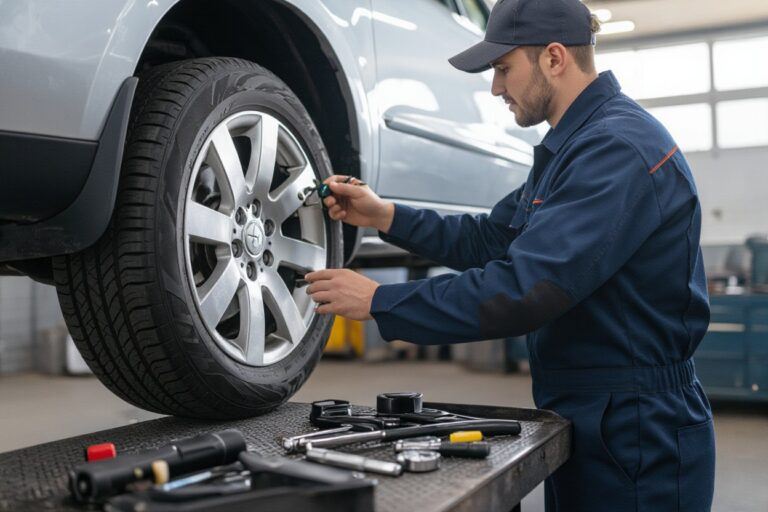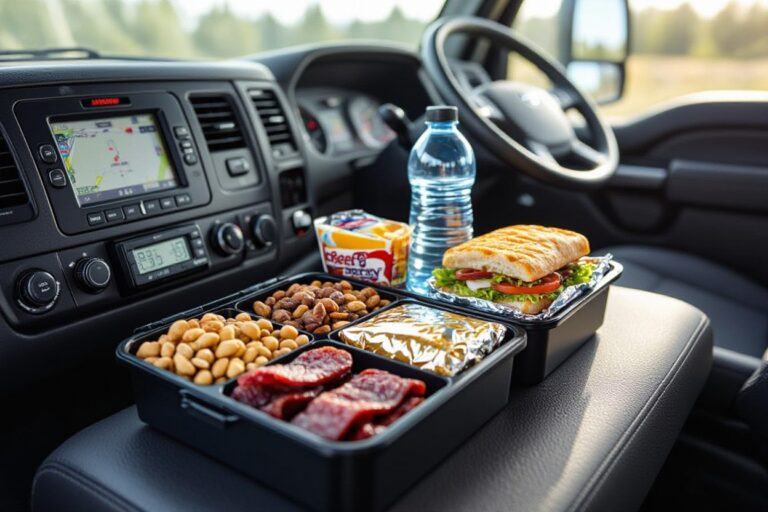It’s vital that you keep a curated stash of snacks in your cab to maintain energy, focus, and safety on long hauls; prioritize long-lasting, nonperishable items and high-protein, low-sugar choices, avoid perishables that can spoil, and store items properly to prevent contamination; the right mix of nuts, jerky, protein bars, dried fruit, and electrolyte drinks helps you stay alert, manage hunger, and drive safer.
Key Takeaways:
- Pack a balance of protein (nuts, jerky, protein bars) and fiber/complex carbs (whole-grain crackers, dried fruit) to sustain energy and curb hunger.
- Choose non-perishable, low-mess, easy-to-eat options and pre-portion servings to keep the cab tidy and safe while driving.
- Include hydrating choices (water, electrolyte drinks) plus occasional fresh produce (apples, baby carrots) for alertness and overall health.

Fueling the Road: Nutritional Essentials for Long Hauls
Load your cab with a mix of shelf-stable and fresh options: Greek yogurt, beef jerky, mixed nuts, whole-grain crackers, apples, hummus, and hard-boiled eggs. Plan snacks every 3–4 hours and aim for 200–350 kcal per snack to avoid the mid-shift slump. Steer clear of high-sugar sodas and candy that trigger a blood sugar crash, and keep a water bottle plus an electrolyte option like coconut water on hand.
The Importance of Balanced Snacks
Pair protein with fiber and a little fat to prolong satiety—examples: 20–30 g turkey jerky with an apple, or Greek yogurt topped with 1–2 tbsp chopped nuts. These combos blunt cravings, stabilize glucose, and reduce the temptation for fast-food runs. High-sugar, low-fiber choices spike insulin and lead to rapid energy loss, so prioritize snacks that deliver steady fuel and keep you focused behind the wheel.
Key Nutrients to Keep You Alert
Prioritize protein, complex carbohydrates, soluble fiber, healthy fats, B vitamins, and electrolytes: protein (20–30 g) supports alertness, complex carbs sustain energy, and B6/B12 aid metabolism. Omega-3s and unsaturated fats support cognitive function. Replace salty, sugary convenience foods with nut mixes, tuna packets, whole-grain bars, and electrolyte drinks to maintain performance and reduce fatigue.
Practical pairings: a hard-boiled egg + whole-grain toast for B12 and steady carbs; almonds + dried berries for healthy fats and quick glucose; hummus with carrot sticks for fiber and protein. Use low-sodium beef jerky or canned salmon for portable protein, and choose sports drinks with electrolytes only during heavy sweating to avoid excess sugar. Track how specific snacks affect your alertness and adjust portions accordingly.
Top Powerhouses: The Best Non-Perishable Snacks
Nuts, jerky, protein bars, canned tuna, nut butters, roasted chickpeas and whole-grain crackers form the non-perishable backbone you can rely on for long hauls. Protein bars often deliver 10–20g per bar, nuts provide about 6–7g per ounce, and single-serve tuna cups offer 20–25g of protein. Watch labels: jerky and some bars carry high sodium while dried fruit can have high sugar, so balance with fiber-rich options.
Protein-Packed Options for Sustained Energy
Beef jerky packs roughly 9–10g of protein per ounce and fits in tight spaces; opt for turkey or low-sodium varieties to cut salt. Shelf-stable tuna or salmon cups deliver 20–25g per 3-ounce serving, and single-serve nut butters give about 7–8g per two tablespoons. You should target protein bars with at least 10g protein and under 15g added sugar, and rotate roasted chickpeas or edamame snacks for plant-based options.
Healthy Carbohydrates to Keep You Going
Whole-grain crackers and crispbreads supply complex carbs and typically offer 3–5g fiber per serving; instant oats give around 4–5g fiber per half-cup dry. Dried fruit and granola deliver quick glucose for short bursts but can carry 20–30g of sugar per serving, so you pair them with protein or nut butter to avoid rapid energy crashes.
Pairing matters: combine a 4g-fiber whole-grain cracker with 2 tablespoons of peanut butter (≈7g protein) to blunt blood-sugar spikes and sustain fuel for roughly 2–4 hours. Oats and legumes have lower glycemic loads, offering steadier energy than simple sugars; alternate dense carbs (oats, brown rice cakes) with quick carbs (dried fruit) so you maintain focus without frequent crashes.
Sweet Relief: Satisfying Your Sweet Tooth Responsibly
You can curb cravings without derailing focus by favoring low-added-sugar options and portion control. Aim for snacks with under 15 g added sugar or pair a sweet item with protein or fiber—example: a medium apple (~95 kcal, 4 g fiber) plus 10 almonds—to blunt glucose spikes and extend energy. Avoid large candy bars (often 20–30 g added sugar) that produce quick crashes and impaired alertness.
Natural Sugars vs. Processed Snacks
Dried fruit like apricots or raisins offers concentrated natural sugars plus fiber and micronutrients, but portion matters—1/4 cup can contain as much sugar as a small candy. Choose fresh fruit or single-serve dried portions and compare labels: many granola bars carry 10–20 g added sugar. Pair natural sugars with a protein source (cheese stick, nut butter pack) to stabilize blood sugar and sustain driving performance.
Delicious Treats That Won’t Weigh You Down
Select portion-controlled options: 1–2 squares of 70% dark chocolate (~50–100 kcal) with 10–12 almonds, single-serve Greek yogurt (if refrigerated) or shelf-stable protein pudding, and freeze-dried fruit packets. These choices deliver sweetness with less added sugar, healthy fats, and protein to keep you alert between stops without the heavy slump.
Pack practical portions and storage solutions: keep individually wrapped dark chocolate squares, single-serving nut-butter packets, and pre-portioned trail mix (30 g servings) in resealable bags. Target snacks around 150–200 kcal or combine a ~100 kcal sweet item with a 50–100 kcal protein/fat bite; this balance reduces cravings and prevents the quick energy crashes that come from high-sugar treats packed alone.

Hydration Happiness: The Best Drinks for Truckers
Keep your cab stocked with drinks that do more than quench thirst: electrolyte mixes (for long hauls), coconut water, unsweetened herbal teas, and low-sugar sports drinks. Aim for roughly 2–3 liters daily on typical days and more in heat or heavy sweating. Avoid sugary sodas and energy drinks that pack 20–40 g sugar per 12 oz, which spike energy then crash you when you need steady focus.
Top Hydrating Options Beyond Water
Electrolyte tablets like Nuun give sodium and potassium without excess calories; coconut water supplies about 400–600 mg potassium per cup. Low-fat milk offers hydration plus protein for longer satiety, while diluted 100% fruit juice (half juice, half water) restores carbs without overload. Sparkling water with a splash of citrus keeps flavor without sugar. Watch labels: many sports drinks contain 20–30 g sugar per 12 oz, so choose low-sugar versions for sustained hydration.
Caffeine: Friend or Foe?
Caffeine boosts alertness—one 8 oz coffee averages ~95 mg—but relying solely on it masks sleep debt. Use caffeine strategically: 100–200 mg can sharpen short-term focus, yet doses above 400 mg/day raise heart rate, anxiety, and sleep disruption risks. Energy drinks often deliver 160–300 mg plus sugar, creating quick energy followed by crash. Pair caffeine with planned breaks and naps, not as a substitute for proper rest.
Timing matters: caffeine’s half-life is roughly 3–5 hours, so avoid it within about 4–6 hours of your planned sleep. Try a 20-minute “caffeine nap”—consume ~200 mg, nap 20 minutes, then wake with amplified alertness. Monitor interactions if you take medications or have hypertension; cut back if you notice jitteriness, palpitations, or impaired sleep. Spread intake across the day and prioritize hydration alongside caffeine to reduce side effects.
Packing Smart: Organizing Your Snack Stash
Arrange your snacks by type and shelf life: designate a cooler zone for perishables, a dry-bin for shelf-stable items, and an easy-reach zone for driving snacks. Use clear containers and label with dates so you can apply first-in, first-out (FIFO) rotation. Secure bins with bungee cords or non-slip liners to prevent spills while driving, and keep bulky items low to maintain cab balance and accessibility.
Optimal Storage Solutions in the Cab
Invest in a small 12V compressor fridge or quality insulated cooler with frozen gel packs to keep perishables below 40°F (4°C); carry airtight containers, vacuum-sealed bags to extend shelf life, and quart-size resealable bags for portioning. Stackable plastic bins, a magnetic spice/condiment rack on metal surfaces, and Velcro straps for jars maximize space and prevent shifting on long hauls.
Snack Rotation: Ensuring Freshness
Mark purchase or packing dates with a permanent marker and place newest items to the back so older goods get used first. Check seals and sell-by dates weekly, and toss anything with off-odors, bulging packaging, or visible mold. Keep a simple inventory on your phone to track items older than a week and prioritize them before loading fresh supplies.
Follow time-temperature rules: discard perishables left above 40°F (4°C) for over 2 hours, or over 1 hour if temperatures exceed 90°F (32°C). For routine rotation, create a weekly checklist—consume refrigerated proteins within 2–3 days once opened, use frozen water bottles as ice packs for 24–48 hours, and reseal or refrigerate opened jerky or cut fruit immediately. Position oldest items at the front of bins so you grab those first on the road.
Final Words
Presently you have a solid list of top snacks to keep in your cab; choose options that balance energy, shelf life, and ease of eating so you stay alert, comfortable, and fueled on long hauls. Rotate supplies, check expiration dates, and favor portable, nutritious choices to maintain performance and reduce downtime.
FAQ
Q: What are the top 10 snacks every trucker should keep in the cab?
A: 1) Mixed nuts (almonds, walnuts, cashews) — high in protein, healthy fats, long shelf life; 2) Jerky (beef, turkey, or vegan) — concentrated protein, compact and nonperishable; 3) Fresh fruit with longer shelf life (apples, oranges, bananas stored properly) — quick energy and fiber; 4) Dried fruit (dates, apricots, mango) — portable sweetness and nutrients; 5) Whole-grain crackers or rice cakes — complex carbs for sustained energy; 6) Nut butters in single-serve packs — protein and healthy fat without utensils; 7) Greek yogurt (single-serve, kept in a cooler) — protein and calcium for refrigerated setups; 8) Trail mix or granola (low-sugar options) — balanced carbs, fats, and protein; 9) Protein bars or meal-replacement bars — fast, filling, and portion-controlled; 10) Veggie sticks or single-serve hummus (in cooler) — fresh crunch and savory protein. Choose variety across protein, fiber, and healthy fats to avoid energy crashes.
Q: How should snacks be stored and organized in the cab to stay fresh and safe?
A: Use airtight containers and resealable bags to prevent spills, moisture, and pests; keep dry goods in a dedicated, shaded compartment away from direct sunlight and engine heat; use a small cooler with ice packs for perishable items and change ice regularly; portion snacks into single-serve bags to control portions and reduce waste; label containers with dates and rotate stock using FIFO (first in, first out); clean up crumbs and food debris after eating to avoid attracting insects or rodents; secure heavier containers to prevent shifting while driving.
Q: How can truckers balance convenience, nutrition, and shelf life when picking snacks?
A: Prioritize a mix: shelf-stable staples (nuts, jerky, crackers) for long hauls, and a few refrigerated items (yogurt, hummus, fresh fruit) for short segments when a cooler is available. Aim for combos that pair carbs with protein or fat (apple + nut butter, crackers + cheese) to sustain energy. Choose low-sugar, high-fiber options to avoid energy spikes. For dietary needs, select low-sodium jerky, gluten-free crackers, or high-protein bars with minimal added sugar. Prep simple portions at home to save time on the road and reduce impulse stops: pre-cut veggies, single-serve packs, and labeled containers. Stay hydrated with water; caffeine is fine in moderation but shouldn’t replace balanced snacks.



